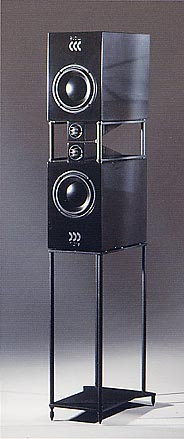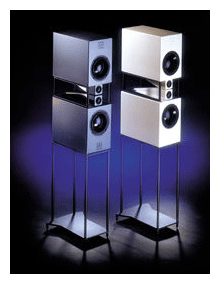You are reading the older HTML site
Positive Feedback ISSUE
18
march/april 2005
morel
Octwin 5.2 loudspeakers
as reviewed by Ed Morawski

|
ED MORAWSKI'S SYSTEM:
LOUDSPEAKERS
ELECTRONICS
SOURCES
CABLES
ACCESSORIES
|
This was a busy month for review equipment at my place! Several pairs of speakers arrived at once, and one of the most anticipated was the Morel Octaves. I had been interested in hearing these for quite a while! The Octaves came in several more cartons than I was prepared for—two large and two small ones. There are two different versions of these speakers, and there are different configurations depending on whether you use them in pairs (Octave) or quads (Octwin). The Octave Ms are made from MDF and cost about half the price of the original Corian version. This review covers only the MDF versions. It breaks down like this: The Octave Ms (MDF version) are $2200 a pair, plus $600 if you want Morel's stands. The Octwin Ms (MDF version) are $4000 plus $300 for the ST11 stands. The Octave Corian version is $4400 a pair plus the same $600 for the stands, while the Octwin Corian version is $8000 for two pairs of speakers plus $900 for the stands.
The larger cartons contained two pairs of Octaves, one red and one black. I was surprised by their small size (7 x 12 x 12 inches). They look much larger in the pictures! The tweeter is located in a molded section on top of the main cabinet. I was extremely pleased with the finish of the speakers. I expected the MDF versions to be dull, but both were very high-gloss, almost like plastic. I thought at first that Morel had mistakenly sent the Corian versions, but was assured that these were in fact MDF.

The other boxes contained the steel stands. These must be assembled, but the tools are included. It took about thirty minutes to put them together. I decided to try just one pair of the Octaves first. (When you combine one pair with a second, the assembly becomes an Octwin.) Since I was reviewing another pair of speakers in my listening room, I set the Octaves up in my home theater system as the front pair. Though the Octaves look tiny, they produce a large sound, and I was also immediately struck by their refinement. They sounded exceptionally clear and precise. Over the next week, the Octaves became invisible. I tried the second pair as surrounds, and the combination was excellent. Movies sounded better than ever. The only drawback to this was the price tag—$4000 for home theater speakers is on the high side, and I wasn't totally convinced they were worth that much.
After the other speaker review was completed, I moved the Octaves into my dedicated listening room. I again tried just one pair, and again experienced their considerable refinement. At $2200 per pair, they could be considered a bargain. The treble was top notch, the bass was decent, and the imaging good. I wasn't sure whether adding another pair would be worth the extra $2000, but felt that I owed it to Morel to judge them as such. To create the combination, a pair of adaptors called ST11s is provided. These fit on top of the first pair of Octaves, then you place a second Octave on them, upside down so that the two tweeters are adjacent. Wiring the two pairs of speakers is a bit tricky, as normal jumpers will not reach the top speaker. I used a second pair of short speaker cables. This results in a 4-ohm load, so have plenty of amplifier power handy! My bridged Bel Canto eVo2s had no trouble, but they are capable of more than 500 watts per channel.
I couldn't believe my ears when I turned on the system. I was so shocked that I disconnected the top pair and listened again. With only one pair playing, the sound was okay. These weren't the best speakers I'd ever heard, or the worst, but when I reconnected the top pair, I was blown away. The sound got louder and better. The most noticeable changes were an increase in richness and a dramatic deepening of the bass. Not only did bass notes have more weight, but the soundstage expanded and deepened. My room expanded in all directions.
Only then did I become aware of the tweeters. They are tiny, yet since they are crossed over at a relatively low 1400Hz, they contribute a great deal to the sound, and they are up to the task. These are probably the most refined tweeters I have ever heard! I can't help but wonder whether Morel designed them to mate so well or was it just a happy coincidence? I already had two pages of notes, and I was only halfway through the first CD! I have probably heard Norah Jones' debut album a thousand times, but it had never sounded this good. My 10 x 10-foot room was filled to overflowing with her husky voice. The piano sounded totally real, and arrayed beside and behind her were the rest of the band.
These speakers reproduce piano better than any others I've heard. The notes are not muffled or off pitch. They are precise but not sterile, and the precision is astounding. As realistically as every instrument is portrayed, there is not a hint of harshness or brightness. Madonna's American Life went in next, and I sat transfixed at the sound of this mixture of electronics and live instruments. The funny thing was, I had never noticed just how many live instruments there were! The Octwins were able to distinguish all of them. Violins that previously sounded mixed in with the overall sound took on their own personalities, yet retained the same textures as before. The bass was phenomenal! Although each Octave has only a 5.25-inch woofer, they sounded like ten-inch drivers, perhaps even producing more bass than a normal ten-inch could. The exciting part was the speed. I had never realized how fast this recording was.
I hate clichéd descriptions like "warm," "bright," or "forward," or comparisons to colors. I try to put my experiences into words that anyone can understand, but I have had a bit of trouble coming up with words to describe the sound of the Octwins. I love writing good reviews, but these speakers deserve better, so I will try to describe them without using the clichés. The Octwins are the most refined speakers I have ever heard. Their unbelievable powers will allow you to hear details you have never discerned before. (Okay, that's a cliché, but I didn't just hear one or two new sounds. I was constantly surprised by previously undiscovered nuances.) The Octwins sound great on every kind of music. I played everything from jazz, rock, and country to pop and instrumental music, and there wasn't anything that didn't sound good.Then there is the Octwins' uncanny ability to expand the soundstage beyond physical boundaries while simultaneously enveloping the listener. This is still a bit of a shock to me, and I have not quite come to grips with it.
As the weeks passed, I did encounter a few nits to pick. Repositioning the Octaves on my 24-inch Target stands, while still using the ST11 adaptors between them, resulted in improved midrange response, probably because the Target stands are a bit lower than the Morel stands. The other nit was a little more serious. The Octave appears to be a bass reflex design, although the manual doesn't say so. There are two triangular cutouts in the back of each speaker. I assume these are ports, since air and sound emerges from them. Although you'd expect a fair amount of excursion from the lower driver, when I played Keiko Matsui's "Whispers in the Mirror," it was more than I bargained for! When the synthesizer kicked in, the Octwins went ballistic. The low-range drivers began flapping, and I could hear their distress over the music. Turning the volume down settled things, but I was very disappointed. It only occurred with this recording, but no other speakers have exhibited this behavior. In all other regards, the Octwins' bass was exceptional. Another of Matsui's CDs, Deep Blue, caused overexcursion, but only at much higher levels.
I couldn't avoid comparisons, since I had two other pairs of speakers, the Mobile Fidelity OML-1s and the Usher X-719s, on hand at the same time. I played each pair, then switched to the next. The differences were very obvious, and the Octaves were the most refined without a doubt, with the Ushers at the other end of the scale. The Octaves' tweeters were far and away the best, though the OML-1s were very, very good. The Ushers had the most bass, but it was a trifle sloppy compared to the Morels'.
Are the Octwins worth $8900? Can I put a price on the best speakers I've ever heard? There few speakers, in their price range or beyond, that can hold a candle to them. There must be a million dollars worth of engineering in these little boxes, or a lot of magic! The Morel Octwins are extremely refined, articulate, detailed, and accurate while very neutral. I haven't heard the Corian version, so can't say whether the huge price increase is justified, but I'd be interested to find out. Ed Morawski
Octwin loudspeakers
Retail: $8900/pair (as reviewed)
Morel
web address:
www.morelhifi.com
North America Distributor:
Jason Scott Distributing, Inc.
8816 Patton Road
Wyndmoor, PA 19038
TEL: 800 Morel-14
email address: [email protected]
